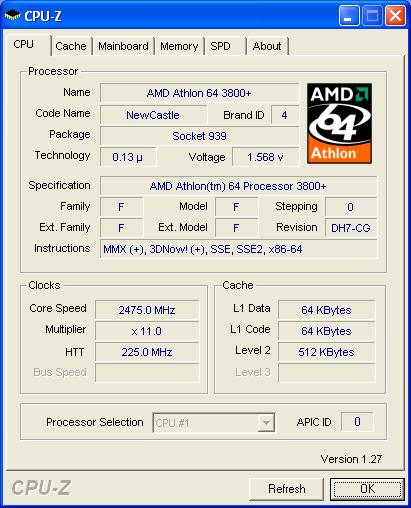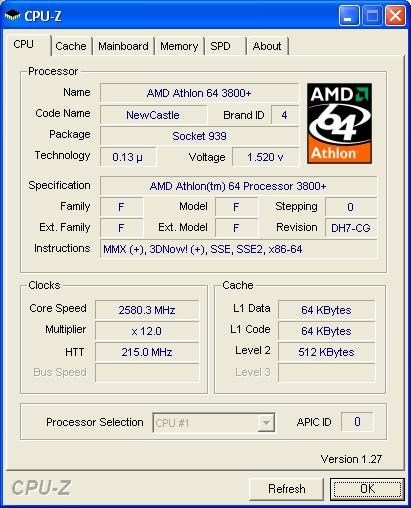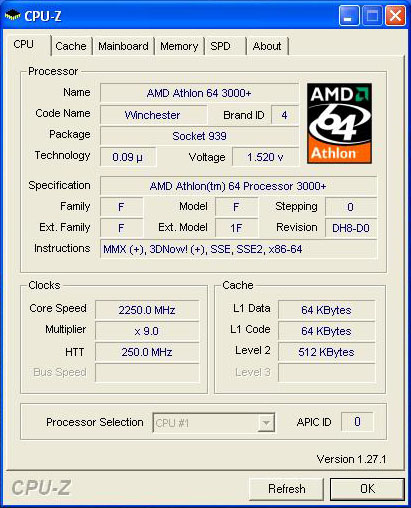Overclocking
With Athlon 64 processors being downward multiplier unlocked, overclocking options are abundant. We have a 3800+ CPU running at 2.4 GHz with a 12X multiplier. In theory, then, a 10X multiplier and a 240MHz bus would give us the same 2.4GHz. That doesn't necessarily translate into dramatically improved performance, but at least it should let us know whether or not the motherboard can properly run with a higher bus speed. Here are the overclocking results that we attained with the current BIOS revision.
Maximum FSB

We were unable to get the system to run properly with a CPU bus higher than 224MHz, regardless of what RAM timings, HyperTransport multiplier, CPU voltage, etc. that we had specified. We ended up using 2-3-2-6 timings, but we are clearly limited by something other than the RAM. That is a rather disappointing result as far as overclocking is concerned. Unless this is improved, those looking at purchasing a 90nm Athlon 64 3200+ and overclocking to 2.5GHz are going to be disappointed. Our guess is that the PCI Express bus is not locked to 100 MHz, so at a bus speed of 224 MHz, the PCIe bus would be at 112MHz. Pushing the speed of the PCIe bus beyond 112MHz would certainly begin to cause issues.
Maximum CPU

Sticking with the maximum 12X multiplier of our CPU, we were able to reach a CPU speed of 2568MHz using a bus speed of 214MHz. Since our 3800+ is a 130nm chip, we are most likely limited by the CPU rather than by the system. (We have not fully tested this particular CPU in other systems, so the maximum overclock is an unknown, but near 2.6GHz is pretty typical for the 130nm Athlon 64 chips.)
Latest BIOS (FN25S906.BIN)

Shuttle sent us results showing the improvements to their latest BIOS revision. They are able to hit a 250 MHz bus without problems, yielding a clock speed of 2250MHz with their 90nm 3000+ chip. They are still working on increasing the supported (and stable) bus speeds to 300 MHz, and we will report results for this once we receive the latest BIOS version.
If you're looking for a really great overclocking SFF, the SN25P appears to be able to deliver. Given the early nature of the product that we're reviewing, future BIOS and motherboard revisions should continue to improve the situation. The initial BIOS that we received didn't allow proper adjustment of memory timings, and later versions were unable to run beyond a 224 MHz CPU bus. Once again, we see that for overclocking support, proper BIOS programming can make or break a system. We still have some reservation about the overclocking worthiness of the SN25P, but assuming that they can get stable support up to 300 MHz, it will be one of the best - perhaps "only" may be the better term - overclocking platforms for socket 939 among SFF systems.













30 Comments
View All Comments
CrystalBay - Wednesday, March 9, 2005 - link
Nice review, 375.00 is that Shuttle's retail price ?I like the PSU is there any rating on the 12v line.
JarredWalton - Wednesday, March 9, 2005 - link
8 - I didn't have any difficulty installing a DVD drive into the SN25P. The "button" has a fairly large range of movement, which allows it to work well. Also, the screw-less design of the CD worked well for me.As far as the graphs go, my intention is to actually go back and add in figures for the SN95G5 and Soltek 3901-300 Pro when I finish testing them, so in the future the charts will hopefully become more meaningful. Having only run one set of benchmarks for this particular configuration made the benchmarks somewhat superfluous for the time being. :|
Gioron - Wednesday, March 9, 2005 - link
One thing that I noticed was that all the noise and heat graphs were on their own seperate scale. This might not be as big a deal when there are multiple cases on the chart, but when there is only one it makes it impossible to just run your eye down the chart and see what the range is. I'd really recommend picking the largest scale and sticking with it for all the charts (and preferably, do the same when there is more than one case on those graphs).Other than that minor layout glitch, a fairly good review. One thing I was wondering, however, was how well the cover over the CD drive works. I know my G5 series case takes a lot of tweaking to get the CD drive positioned just right so that the button will actually open the drive, have they improved that in the P series chasis?
OrSin - Wednesday, March 9, 2005 - link
Not impressed at all.Case too big, and no PCI slot is huge turn off for me.
I think alot SSF users use thier system as HTPC and this system just will not work. I would perfer a wider case, than a taller one. And no PCI slot means no TV tuner or FTA cards.
Maybe I will wait for the one with the ATI motherboard, or the Biostar or just get a HTPC case and get a real motherboard in it.
Oh yeah $400 is little steap even for SFF cases.
JarredWalton - Wednesday, March 9, 2005 - link
#5 - blame my camera. It's definitely NOT a high-end model. Most of the external shots were provided by Shuttle, so I used those as a better quality image. The front panel *does* have a speckled look to it. Maybe I'll see about upgrading to a better camera in the future. Right now, the originals are taken at 2048x1536 (the max of my 3 MP Fuji camera), but after cropping and misc. cleanup I resized them to a more manageable format.IceWindius - Wednesday, March 9, 2005 - link
Ok, why do alot of these picture in their large format look very grainy like it was done in 640x480 mode?IceWindius - Wednesday, March 9, 2005 - link
Well see how well this machine does in the reliable department as many people complained about the SN95g's issues.That and I want to see Creative make a PCI-E soundcard as well as onboard sucks period.
deathwalker - Tuesday, March 8, 2005 - link
#1...for the most part i agree that overclocking wont be a issue with a lot of SFF buyers. One point of concern for me would be the absence of a PCI slot for standard PCI periphrials..such as a TV tuner card..which i have in my system and use frequently.This does look like an attractive device though with a little extra room than most SFF's and a Power Supply with some performance margin in it.
pbrain - Tuesday, March 8, 2005 - link
Fantastic review. Now, where and when are they going be available?!segagenesis - Tuesday, March 8, 2005 - link
And I thought my SN41G2 was expensive at $300 when it was new. Ouch!Good review, however. I dont think overclocking is a major selling point for a SFF when most people want one for noise/size/convenience.